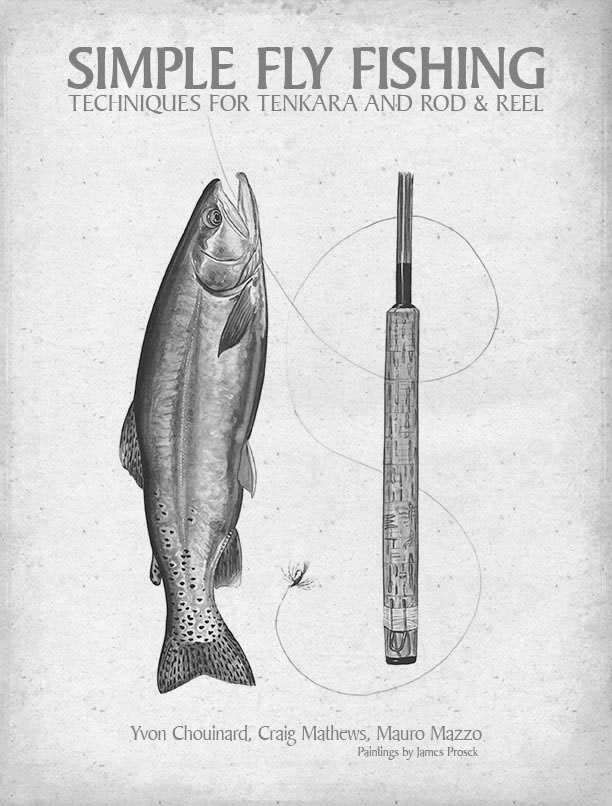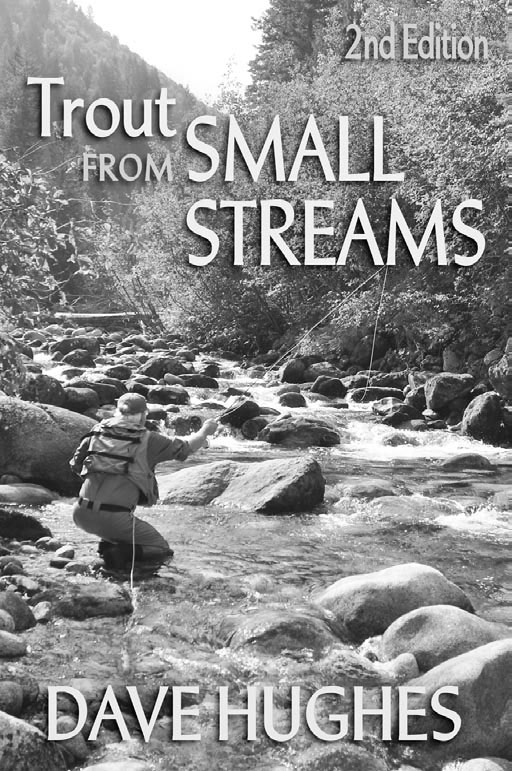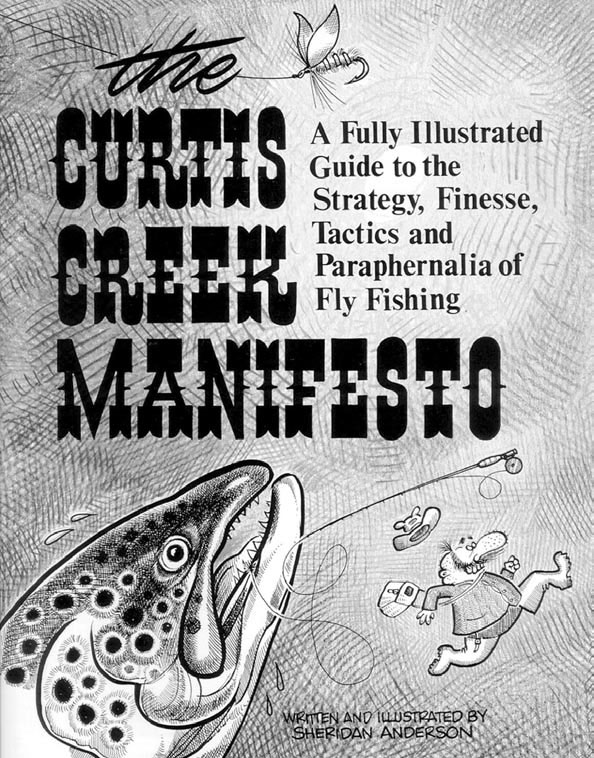Simple Fly Fishing: Techniques for Tenkara and Rod and Reel
By Yvon Chouinard, Craig Mathews, and Mauro Mazzo. Published by Patagonia Books, 2014; $24.95, softbound.
The premise of this book is that fly fishing has become too complicated for its own good. All it takes is a stick, a string, and a bait — in essence, a tenkara kit. Hand this rig to any six-year-old, and she will intuitively make it work.
One of the authors makes the point that it is more difficult to teach experienced fly fishers the art of tenkara than it is to teach a young child. “Expert” anglers try to intellectualize the process, while kids simply do it.
Simple Fly Fishing repeatedly notes that we fish for trout with reels that can stop a motorcycle and rods that can cast a country mile. Meanwhile, the trout are, as they always have been, generally only a few rod lengths away and rarely require a mechanical drag of any type to subdue them. The book introduces the reader to the basic trout foods, their imitations, and places where trout are likely to hang out to eat these foods. The rest of it is about fly-fishing techniques, with the emphasis on the human factor, rather than on the gear involved. As Chouinard says, “The more you know, the less you need.”

For a book that is about simplified fishing, Simple Fly Fishing is rather complicated. It contains much useful information and interesting tidbits, but like a rucksack filled with words, all the information is piled in a heap at the bottom of the bag. There is no glossary or index, and the table of contents is rather sparse and provides little, if any, direction toward the page on which you might learn how to tie a knot or make a cast. But in the end, it really doesn’t matter. You can read this book from front to back, back to front, or just grab random snippets and enjoy it just the same. Each chapter stands on its own legs and can be read like an article plucked from Reader’s Digest. Indeed, most chapters have their own author, and the editor has done a very good job of respecting each writer’s voice, even when doing so slightly jars the cadence of the text. I enjoyed all of it immensely.
I’ve had this book for a couple of weeks and have picked it up to reread parts of it several times a day, every day since it arrived at the doorstep. Chouinard is a master of metaphor, and his “Keep it simple, stupid” philosophy runs just under the surface of every page. Mathews is a meat-and-potatoes kind of angler, and he never stops punching out ideas, observations, tips, and tricks. I don’t know Mr. Mazzo, but I’m willing to bet he is a presentation perfectionist and undoubtedly has a superior sense of where trout will be and what it takes to get them. His European perspective on fly fishing and sometimes uncommon use of American English (“You don’t want your nymph to look like a hangman on a tree”) are refreshing and somewhat disarming. I’d love to fish with him.
My favorite chapter is called “Fishing Situations.” It reads like a round-table discussion, with the three authors being presented with different fishing scenarios. Though they don’t always agree on “the” right technique, their answers carry a lot of wisdom, and the fact that they don’t blindly mimic one another assures the reader that there is no such thing as the “right” way to fly fish.
Surprisingly, though fly patterns are covered in depth, there is no mention of the stereotypical sekasa kebari, reverse-hackle flies that we commonly associate with tenkara. And even though the title suggests tenkara and rod-and-reel techniques might be addressed equally, the truth is that 90 percent of the book is about fishing with a pole that lacks a reel. I’m only guessing that “techniques for rod and reel” was added to the title to make the book easier to swallow for hardcore tenkara skeptics who are still interested in what three masters have to say about fly fishing. These guys do have something to say, and they say it: Get back to basics, keep it simple, and keep it fun.
I thoroughly recommend this book to anyone who has the slightest interest in fly fishing of any kind. I’d also recommend this book to potential fly fishers. It may well be the key that unlocks a new passion.
Ralph Cutter
Trout from Small Streams, 2nd Edition
By Dave Hughes. Published by Stackpole Books, 2014; $21.95 softbound.
The cover of the magazine you’re now holding shows a big brown trout that was caught on a big Sierra foothills river. It’s the type of fish that gets our pulses racing and an image that some might even call fish porn. There’s nothing wrong with that, really, except it can distract us from the satisfying pleasures offered by littler trout in modest-sized waters. And the fact is, California is loaded with small streams that offer excellent angling for fly fishers.
In Trout from Small Streams, Dave Hughes discusses appropriate tackle, flies, and tactics for fishing stream environments that are far more intimate than the larger “blue ribbon” waters we often gravitate toward. He is a thoughtful observer, an extremely experienced fly fisher, and a master at making his points simply and clearly, which is the essence of good teaching.
Although it’s tempting to say the advice Hughes gives is oriented toward novice fly fishers, there is much here to engage all skill levels. I’ve tended to ignore the roll cast, for example, even when fishing creeks, but he highlights its utility and that of the punch cast, of which I was entirely ignorant. Besides, brushing up one’s knowledge is never a bad idea.

Changes between the first edition and the second include the addition of many color photographs and informative captions, plus chapters on reading the seasons and fishing with tenkara equipment. The latter, I suspect, will be of interest, given the recent upswing in the marketing of tenkara. Hughes provides an honest assessment of the pluses and minuses of this form of angling, noting that it is perhaps better suited for medium-sized waters in open terrain rather than smaller streams where casting is constrained by shrubs and trees. For him, too (and surely many of us), an important element in fly fishing is the sensual feel of the casting stroke, a quality that’s diminished in the tenkara approach to angling.
If you’re at all interested in exploring the innumerable smaller rivers and creeks found in California’s mountains, Trout from Small Streams will help you discover that little waters can give much joy.
Richard Anderson
Classics Revisited
The Curtis Creek Manifesto: A Fully Illustrated Guide to the Strategy, Finesse, Tactics and Paraphernalia of Fly Fishing
Written, conceived, and Illustrated by Sheridan Anderson. Published by Frank Amato Publications, numerous editions (first Printing, 1976); softbound.
It looks like a comic book. It reads like a comic book. But looks can be deceiving. The Curtis Creek Manifesto is hands down the greatest fly-fishing primer ever written. This funky manual tells you all you need to know to catch trout. Its author, Sheridan Anderson, has probably led more novices to fly fishing than anyone since Izaak Walton.
The Curtis Creek Manifesto is easy to read, easy to understand, and — above all — easy to pay for. (My copy of the 1978 second edition has a cover price of $3.50.) Anderson’s underground comic book grew out of the author’s supreme dissatisfaction with the majority of how-to-fly-fishing books around, which he found overwritten and impenetrable. Anderson’s goal was to give fly fishers a firm grasp of the basics while entertaining them.
It was a stroke of genius. The Curtis Creek Manifesto is a joy to read and a genuine work of art. The illustrations and hand-lettered text meander playfully across the book’s 48 pages. The drawings range from the kind of serious, detailed illustrations that you might find in vintage Dover Books or in amusing Victorian clip art to the more cartoony images suggestive of R. Crumb, Mad Magazine, Gilbert Shelton’s Fabulous Furry Freak Brothers, and even Ripley’s Believe It or Not. Although at first glance, the artwork appears to dominate the pages, the book is packed with arresting and even poetic prose. Often the author employs a mock-serious tone, with echoes of the convoluted, yet precise speech Jeeves uses when speaking to Bertie Wooster. At other times, the author genuinely moves us with his call to cherish fishing and nature.

Although there are no overt references to sex, drugs, and rock ’n’ roll, The Curtis Creek Manifesto is very much in the spirit of its times. Anderson’s off-kilter, sideways approach to life and fly fishing has a distinctive counterculture and hippie feeling. That sensibility must have some kind of a universal appeal, because The Curtis Creek Manifesto has gone through numerous editions over the years and has sold “several hundred thousand copies,” according to its publisher, Frank Amato Books. Not a word of the text or the original printing and pagination has changed in any way, except to correct a typographical error that appeared under the author’s photograph in earlier editions. Over time, this book has come to be regarded almost universally as the single best book to give a would-be fly fisher. And even “experts” can gain a lot from its wisdom and humor, provided they don’t take themselves or their sport too seriously.
Right from the start, Anderson announces his intention to cut through the bull in his “Preamble and Opening Salvos”:
Here then is the Curtis Creek Manifesto, a unique and very visual work designed to eliminate the guesswork and confusion inherent in orthodox textbooks which rely too heavily on the printed word. This highly graphic primer is a distillation of almost ninety years of fly fishing experience (thirty years of my own/sixty years of my mentor, uncle and collaborator, Grant Wooton). The Manifesto won’t guarantee a posy of trout on your first fishing trip but it will set you solidly on the right path to becoming a worthy angler.
Read it through at least twice and take it along when you go fishing to use as a reference. If possible, latch on to a knowledgeable angler to go fishing with — a good teacher is worth more than all the angling literature ever written. Don’t forget to send him a card on his birthday and a bottle of fancy booze at Christmas time.
The preamble is followed by the author’s “Eleven Commandments,” presented in hand-lettered gothic script: “Thou shalt know thy knots well and rig thy gear in an artful manner”. . . “Thou shalt fish upstream” . . . “Let not thy shadow nor that of thy rod fall upon the waters” … finally ending with the most important commandment of all: “Thou shalt love the waters and all things that nourish therefrom; and thou shalt cherish and protect them as thine own ~ For all nature is thy home and all living things are thy kin.”
The author then leads the reader step by step through what it takes to become a competent fly fisher, starting with the basics and then delving into a few of the complexities.These include “Mustn’t Scare,” “Stalking,” “Fish Upstream,” “Reading Water”, “Strike!” “Playing,” and such things as “Flies and Foofaraw.” Several pages are devoted to streamside entomology and the imitation of natural insects, but Anderson lets readers in on the simple truth that “a hotshot angler can probably do pretty well anywhere in the country armed with nothing more than a #16 gold-ribbed hare’s ear.” More important is how to approach the quarry and get the fly on the water without scaring the fish.
Sections on tackle and gear emphasize whatever is cheap and utilitarian. (“Rod Medicine” shows you how to repair a broken rod with a chopstick!) There are comic panels titled “Fly-Casting” and “Fly-Tying,” with easy to follow, step-by-step illustrations that cut through the fog. Anderson even breaks free from the orthodoxy of fly fishing with helpful hints for slinging bait, “dapping” through the underbrush, and “guddling” — the art of sneaking up on a trout and catching it with your bare hands. There is an emphasis on catch-and-release fishing, along with illustrations on how to gut and cook the fish.
The author covers all these subjects with energy and wry humor. He is big on simplicity and small streams and advises the beginner to start out on creeks — because “a creek demands a certain delicacy that is impossible to learn on a big river. This is why a good creeksmith can readily adapt to a river, but a big-water angler is the proverbial bull-in-a-china shoppe when confronted with a brook.” (What would he have made of tenkara?)
If there is an emphasis on any one thing in this book (other than retreating to the nearest bar or tavern during inclement weather), it is the importance of stealth. Repeatedly, he advises anglers to stalk trout on hands and knees. He calls this “the most effective tactic in fly fishing” — yet a skill almost universally neglected. “I don’t recall ever seeing the cover of a fishing gazette depicting an angler on his knees, much less crawling.”
Summing up “The Priorities of the Game,” the author lists “the five most essential disciplines for becoming a good fly fisherman.”These are casting, selecting the fly, stalking, recognizing the strike, and reading the water. And he issues a call to arms, noting that most of the waters he fished as a kid are messed up, thanks to pollution and greed. He ends with a question: “Is There Really a Curtis Creek?”
(Yes, a tributary to the Blacksmith Fork River, not all that far from Salt Lake City, Utah, where Anderson grew up, but he doesn’t clue us in on that.) Here is how he answers the question of whether Curtis Creek actually exists: “Possibly, my darlings, quite possibly; but I will say no more because that is your final lesson: To go forth and seek your own Curtis Creek — a delightful, unspoiled stretch of water that you will cherish above all others. There are few Curtis Creeks in this life so when you find it, keep its secret well.”
Anderson’s subversive and idiosyncratic book was the product of a free spirit and a deeply eccentric mind. On the author’s page, the caption beneath his photograph identifies him as “angler, artist, wanderer, eternal foe of the work ethic” — the only job a grown man should have. He hung out with the Yosemite rock-climbing crowd and people such as Royal Robbins and Yvon Chouinard, drawing cartoons and caricatures for backpacking and climbing magazines. Frank Amato pulled Anderson’s trout-fishing manual out of the slush pile, and literary history was born.
Sometimes eccentricity hides a profound sadness. Anderson hit the bottle hard. (“From the first drink I ever had, I knew this was what I wanted to do.”) He once wrote of himself: “Frequently in the execution of his artistic and literary pursuits, Mr. Anderson is wont to employ spirits to prime and sustain his muse.” Booze got the better of him. Alcoholic and overweight, the author died at age 47 from an attack of asthma and emphysema, probably exacerbated by drinking. His passing was premature and sad. His book is balm for our loss.
Michael Checchio





